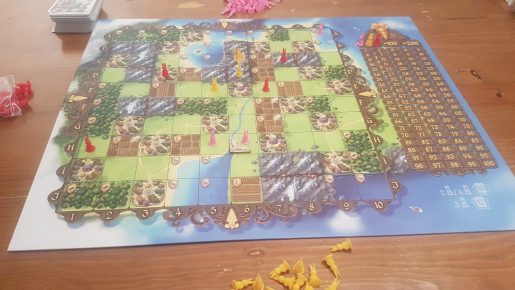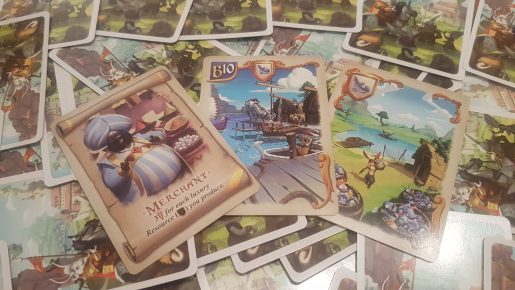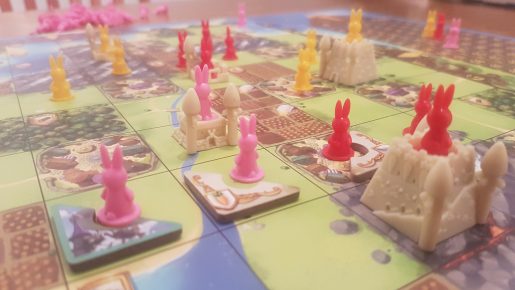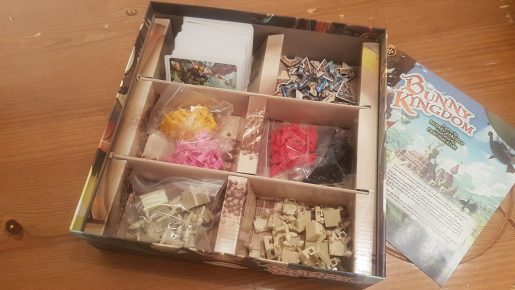Bunny Kingdom, release last year by IELLO, is a board game with unsurprisingly a bunny theme, which has elements of area control and card drafting. Designed by Richard Garfield, with art from Paul Mafayon, the gameplay sees 2 – 4 players spend around 45 – 60 minutes taking control of a bunny clan. With mountains to climb, carrot fields to control and cities to build, Bunny Kingdom looks to put a cute theming onto a potentially aggressive game. However, does the game warren-t a play? Let’s find out!
Players start with an empty 10×10 grid map, a pile of special tokens and a well shuffled deck of exploration cards in the middle of the table, with each person then getting a coloured set of 36 bunnies (one being placed on the scoreboard). Bunny Kingdom is played out over four rounds, with each round the players being dealt an amount of exploration cards, the number being determined by the player count. This is where the drafting stage begins, the first of three phases.
On a turn players will select two cards from their hand to play, with the rest being passed either clockwise or anticlockwise to the next player. Everyone is doing this simultaneously so before revealing the two cards you’ll play everyone has to be ready to play. Note, this can cause a slight delay if players are choosing between a lot of good cards. When all player have chosen their two cards, they are played.
There are four types of cards, which each do a unique thing. The most common card type is a Territory card; these have a letter and number which corresponds to a location on the board. By playing a territory card the player claims the indicated location, placing a bunny from their reserve onto the board. Parchment cards are kept hidden, being left face-down on the table in front of the player, offering a special way to score points – with some even offering straight victory points. Provision cards offer the one-time bonus of immediately drawing and playing two cards from the deck. This can be risky as you don’t know what you’ll get but it is still getting you two cards from selecting one.
The final type is building cards, which come with a type and potentially a strength. Buildings can be anything from gold farms through to cities. Farms give a player an additional resource type for scoring, with some coming with specific placement limitations. Sky Towers link two different fiefs you control together and are the most advanced of the buildings. Cities come in three strength categories, helpfully denoted by the number of towers the city pieces have. Unlike claiming territories buildings are added to the board during the second phase, construction, which take place after all cards of a round have been played. Note, that just because you have played a building does not mean you have to construct it that round.
Scoring takes place at the end of each round, though the scores towards the end of the game always outweigh those seen in round one. This is simply due to the amount of cities built as scoring consists of multiplying the number of types of resources by the total city strengths in a group of adjacent spaces, or fief. For example a fief with 2 cities of strength 2 with wood and mushroom resources scores 8 points [(2+2) * 2]. It is key to explain to new players no matter how many of the same resource they have it only counts once, as intuitively more is better. This does lead to players purposefully not taking spaces that would link smaller fiefs together unless they can guarantee that the city count is enough to warrant it. At the end of round 4 players do final scoring including any points earnt from parchment cards, with the winner whomever has the most points.
In a weird way the scoring system reminds me heavily of King/Queendomino. The multiplication used to combine the harvest resources with the combined strength of cities, matches the territory sizing and crown symbols. This has enabled me to springboard some gamers from the light game of Kingdomino into the experience somewhat easier. The games are far from identical, though if you enjoyed the logic of building up areas in Kingdomino then Bunny Kingdom offers a similar vibe.
The production quality of Bunny Kingdom is very high, with over 140 small plastic bunnies, nice artwork on the 100+ cards and the tactile city pieces that players will build across the board. One aspect that does slightly let the quality down are the special tokens, which I struggled to smoothly remove from the punchout sheets; though this might be just an issue with my copy. While the cardboard is of decent thickness, it is slightly odd to place them on the board alongside the bunnies and cities that are made of plastic. Also, with the amount of tokens it would be unlikely to have altered manufacturing massively if they were consistent and made from plastic. Note, IELLO stepped up when the community complained about the size of the original board size, but playing on the new larger board the issues have seemingly been resolved.
Included in the rules are some tweaks to make the gameplay, more specifically the drafting, 2 player friendly. All cards are still included, the area control mechanics are left untouched and there is no dummy player in sight. Go down to the lowest player count and be prepared for an even more cutthroat experience. During the drafting instead of playing two cards each turn you only play one but also discard a second card. Hate drafting, the process of actively taking something an opponent would want, is still prevalent in 3 – 4 player games. However, with more people players can fall into the logic that others can stop someone getting what they need instead of them, ending up seeing players getting what they want. When it is just you versus an opponent don’t discard the cards they need and be prepared to pay for it in points.
I was hesitant when I originally saw Bunny Kingdom, the final board looked extremely busy and that was enough to make me worry about the rest of the design. IELLO has fixed this issue by including a larger board, allowing the rest of the components to sing rather than feel stuffed together and people to focus on playing instead of just reading the board. There is a nice amount of choice, driven by the ability not to instantly utilize any building types, that build upon the drafting gameplay – giving it depth that flows from one turn to the next. Bunny Kingdom ends up feeling like a mixture between Sushi Go Party! and Kingdomino, two extremely popular titles. Nevertheless, it does enough to stand apart from both, nest its way onto my gaming shelf!
[Editor’s Note: Bunny Kingdom was provided to us for the review by Coiledspring Games.]





